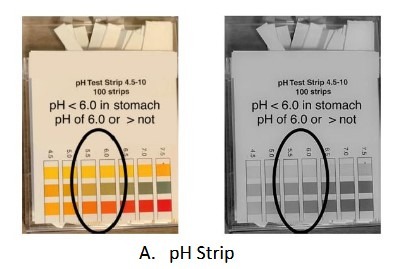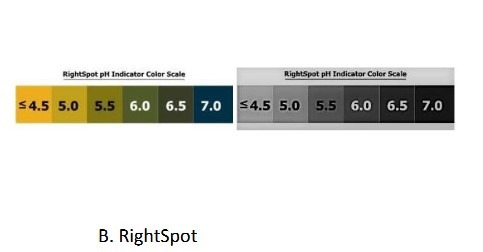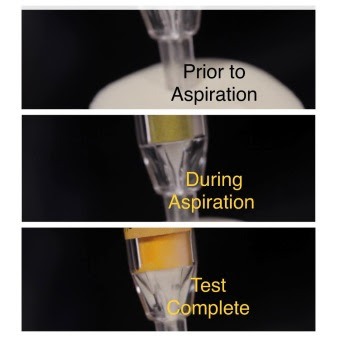Why Use the RightSpot™ pH Indicator?
A RightBio Whitepaper
Marcia L. Zucker, Ph.D., President, ZIVD, LLC
Don Marcello, Director, RightBio Metrics, Inc.
The RightSpot™ pH Indicator is an in vitro diagnostic pH test device for the evaluation of gastric acidity. It is intended to verify initial placement of any tube intended to end in the stomach and to rule out displacement of any existing tube by verifying the tube ends in the stomach. A resulting pH of 5.5 or below indicates gastric acidity and therefore placement in the stomach.
Why Use pH?
According to the American Society for Parenteral and Enteral Nutrition (ASPEN), the placement of a nasogastric tube (NGT) is a common practice that is generally perceived as a benign bedside procedure. However, there is potential risk for NGT misplacement with each insertion and additional risk of tube displacement over time. A misplaced NGT compromises patient safety, increasing the risk for serious and even fatal complications. Currently, there is no standardized method for verification of the initial NGT placement or reverification assessment of NGT location prior to use¹.
Measurement of the acidity or pH of the gastric aspirate is the most frequently used evidence-based method to verify NGT placement, although a radiograph, when properly obtained and interpreted, is considered the gold standard to verify NGT location. The use of x-rays, however, is a procedure that comes with its own risks. To minimize risk and improve patient safety, there is a need to identify best practice and to standardize care for initial and ongoing NGT location verification¹.
The Patient Safety Movement Foundation (PSMF) is an organization of individuals with expertise in many areas including clinical operation, data management and analytics and strategic quality improvement. They are focused on eliminating preventable medical errors, and have published several Actionable Patient Safety Solutions (APSS), including one on gastric tube placement. Following the insertion of a nasogastric tube, and prior to each use, they recommend confirmation of NGT placement with pH of gastric aspirate targeting the range of 1.0 to 5.5 and only using use an abdominal radiograph if needed².
These evidence-based guidelines advocate supplementary checks on NGT placement at a minimum of: before feeding; at 4-hour intervals after feeding has started; when there is any interruption in feeding; or any suspicion of potential dislodging of the tube¹,²,³. In all cases, these checks are recommended to be done using pH measurements to minimize radiation exposure, minimize wait times for X-ray results and reduce costs associated with radiography. The advantages and disadvantages reported for pH confirmation testing has been reported in many different NGT guidelines and are summarized in a guideline overview from 2019⁴.
Both the ASPEN and PSMF’s APSS guidelines stress that the use of visible signs of distress, auscultation (listening to sounds from the stomach, heart, lungs, or other organs), visual inspection of fluid from the tube, observation of bubbles, and litmus paper are NOT reliable indicators of tube placement¹,².
Why Use RightSpot™ pH indicators?
While the advantages of using pH for NG tube location verification are clear (cost, time to result), and pH can be used in all patient settings (hospital, long term care, home), there are also recognized disadvantages. High in the list of potential disadvantages are the potential for measurement error with colorimetric tests, difficulty in obtaining the aspirate from the NG tube⁴ and pH strip accuracy (sensitivity 68%, specificity 79%) ⁵.
The RightSpot™ pH indicators (regular, ENFit®, and small bore) are CLIA waived, FDA cleared devices that have been designed to minimize all these disadvantages.
Potential for measurement error with colorimetric tests. In typical clinical settings, aspirate pH is tested with a colorimetric paper or test strip. Since these tests require subjective interpretation, it may be difficult to make accurate readings. For this reason, sites often require competency-based training for those undertaking pH tests, providing site coordinators an opportunity to detect if staff members have poor color discrimination (figure 1a).
When using the RightSpot™ pH indicator, the small volume (<0.5 ml) specimen fills from BEHIND the pH paper allowing easy visualization of exact color change regardless of aspirate color or viscosity. The Reference Key is wrapped around each device to readily determine result and carefully chosen color tones are easily interpreted even by those color deficient (figure 1b).
Figure 1. Appearance of pH strips and RightSpot™ color reference to color blind individuals.*
*Appearance of reference indicators for pH strips (A) and RightSpot™ pH indicators (B). In both, the left image is full color, the right image is the same image as perceived by color deficient users.


Difficulty obtaining aspirate from NG tube/ exposure to stomach fluids while testing. Guidelines recommend solving this problem by injecting air boluses into the tube with a large syringe and then applying slow negative pressure to the plunger to withdraw fluid from an adult or turning the child/infant onto the left side, if possible, injecting 1–5 ml of air into the tube using a syringe and waiting for 15–30 min before aspirating again⁴.
The RightSpot™ pH indicator is attached to a syringe filled with air and to the proximal end of the gastric tube. The air is expelled to remove the tip of tube from stomach wall and while observing the RightSpot™ pH Indicator strip, fluid is slowly aspirated to achieve saturation of the RightSpot™ pH Indicator strip (figure 2). As soon as the indicator changes color, the result is read by comparing to the reference label on the shaft.
Figure 2. Appearance of the RightSpot pH indicator during testing.

Even with opaque fluids pH reaction is determinable as the sample fills behind the pH paper. The unique protective single-unit packaging prevents air, light, and humidity from affecting the integrity of the pH paper and cross-contamination is prevented as the pH Reference Key is in the device. Since the RightSpot™ attaches directly to the gastric tube, there is no need for sample transfer that may result in operator exposure to gastric fluids.
Accuracy. Reports of the accuracy of pH strips range widely. Studies evaluating sensitivity and specificity of pH paper readings are often highly controlled samples using instrument read pH paper or laboratorians who are tested for color perception and trained. There have been two published studies specifically comparing the accuracy of the RightSpot™ pH indicators to pH measured by a gastric pH electrode catheter⁶ or a pH meter⁷.
In a study of adults undergoing elective procedures, direct intragastric pH was recorded simultaneously with gastric aspirate pH using the RightSpot™ pH indicator and an external pH electrode. Electrode catheter-determined intragastric pH was compared to the RightSpot™ pH indicator result, as was aspirate pH using the external pH electrode. The sensitivity of the RightSpot™ pH indicator was 1.0 when compared to the direct catheter intragastric pH and the specificity was 0.83. When compared to the external pH electrode determination of aspirate, the RightSpot™ displayed a sensitivity of 0.91 and specificity of 1.0⁶. A study of infants compared pH determined using the RightSpot™ pH indicator to that determined using a pH meter for 230 samples. The RightSpot™ agreed in all (100%) of the samples evaluated⁷.
These studies suggest that the accuracy limitations encountered using pH test strips is overcome by the unique construction of the RightSpot™ pH Indicators.
Conclusion
Evaluation of practice guidelines and peer reviewed publications supports the use of pH as a primary resource to ensure safe gastric tube placement while minimizing risks. The cost savings, availability in all environments and increased safety provided by pH over radiographic imaging cannot be overstated. The use of pH electrodes and meters is generally impractical for the frequent confirmation of tube placement required for patient safety, especially in non-acute care environments (e.g., patient homes, long-term care facilities). The use of pH test strips, while convenient, may lead to inaccuracies due to color perception, sample color interference and ambient lighting. In addition, the use of pH strips can lead to contamination of the patient area and cross contamination between sequential samples.
Each RightSpot™ pH Indicator provides a closed system for specimen collection and testing, using approximately 50 µL of aspirate, and incorporates an on-device color reference key specific to the pH of Gastric or Plural Fluids. Fluids are contained, analyzed, and reported without contamination to the environment or exposure to the patient or clinician. And, by selecting colors which can be interpreted by even those with achromatopsia (colorblindness) any caregiver can use it. Opaqueness of specimen does not hinder determining the resulting pH as the specimen is aspirated to the back of the paper and not over it. This means that the presence of dried coagulated blood, that often resembles coffee grounds, does not interfere with obtaining a correct result.
The RightSpot™ pH Indicator provides a safe, effective, easy to use method for the evaluation of gastric acidity, whether to verify initial placement of the tube or to rule out displacement of an existing tube that complies with evidence-based guideline recommendations.
Clinical References
Irving, SY, Rempel, G, Lyman B., et al. Pediatric Nasogastric Tube Placement and Verification: Best Practice Recommendations From the NOVEL Project Nutrition in Clinical Practice 2018 33:921-7.
https://psmf.org/wp-content/uploads/aebp/APSS-15-NG-Tube-Placement-and-Verification-2020.pdf
Lyman, B, Peyton, MS, Healey, F. Reducing nasogastric tube misplacement through evidence-based practice. American Nurse Today: 13:6-11. 2018.
Metheny, NA, Krieger, MM, Healey, F and Meert, KL. A review of guidelines to distinguish between gastric and pulmonary placement of nasogastric tubes. Heart Lung 2019 48:226-235.
Rowat AM, Graham C, Dennis M. Diagnostic accuracy of a pH stick, modified to detect gastric lipase, to confirm the correct placement of nasogastric tubes. BMJ Open Gastro 2018;5:e000218.
Lambert, CR, Varlotta, D, Posey, M, et.al. Validation of the RightSpot™ device for determination of gastric pH during nasogastric tube placement. International Journal of Emergency Medicine 2013, 6:28.
Martin, G. and Wade, C. Validation Study of the RightSpot Infant pH indicator for verification of feeding tube placement in the neonatal intensive care unit. Neonatal Intensive Care 2015; 28: 64-6.
ENFit® is a federally registered trademark of GEDSA and meets the ISO 80369-3 Standard.
About the Authors:
Marcia L. Zucker, Ph.D. is an established professional with recognized expertise in the medical diagnostics industry and a specialist in point of care testing applications. She is a Fellow of the Academy of the American Association for Clinical Chemistry (AACC) and has served as Chair of the Critical and Point-of-Care Testing (CPOCT) Division. Dr. Zucker is also an active member of CLSI serving as a member of the Expert Panel for Point-of-Care Testing.
Don Marcello represents medical devices specifically designed for patient safety, cost reduction, and supporting best-practices. His 38 years in the industry have provided him with insight and knowledge to support hospitals interested in reducing infection, time delays, and costs; ultimately beneficial to achieving organizational goals of evidence based clinical outcomes.

